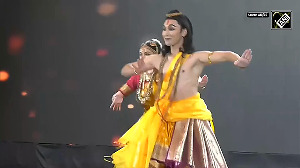The crackdown on social activist mAnna Hazare and his subsequent arrest is agreeably a blatant misuse of power by the Delhi police. But the decision to arrest him and his aides was not taken by the Delhi police, rediff.com has learnt.
The Delhi police, which directly reports to the Ministry of Home Affairs, took decisions all through after 'consultations' with the ministry.
Highly placed sources told rediff.com that the police were merely following "orders." If sources are to be believed, the whole sequence of events, which ultimately led to Hazare's arrest, was plotted and executed by the central government.
First the Delhi police issued prohibitory orders under section 144 earlier this month at the venue where Hazare and his supporters were planning to fast. Sources said that these orders were issued after consultation with the MHA after Hazare refused to specify the duration of the fast and limiting the number of people.
"There was communication between us and the India Against Corruption activists to negotiate the undertaking we demanded from them. This was not successful and we issued prohibitory orders under section 144 after consulting with the MHA," a senior police official said.
What the officer is suggesting is that the government used the Delhi police as an interface between team Anna and themselves.
This is the case even in the present negotiation going on between the police and Hazare inside Tihar Jail.
Top officers are negotiating with the Gandhian inside the jail and his responses are being ferried back to the central government. The apparent softening of the police stand on the seemingly non-negotiable conditions earlier on Hazare's fast is also in consultation with the ministry.
Explaining the sequence of the events leading to the Gandhian's arrest, a senior police official said, "We first sent a three-member police team to the residence in Mayur Vihar in east Delhi where Hazare was staying. We asked him if he would sign the undertaking demanded from him. After he refused, we placed him under arrest under section 107 and 151 of the Criminal Procedure Code. This step was also taken in consultation with the ministry."
Another officer said that the central government had first wanted Hazare to be taken out of the city as was done with Baba Ramdev. But the top brass of Delhi police was not in favour of this as they "feared a law and order situation following this."
"The IAC had already mobilised enough people for the protest. If he had been taken out of the city, it would have led to a law and order situation. We also had information that unscrupulous elements (read RSS) had joined the protestors. Things could have gone out of hand. Moreover, there were other people involved in the protest like the Bhushans, Kiran Bedi, etc. and thus we felt that preventive arrests would be the best option," the officer said.
Following his arrest at 7 am on Tuesday, Hazare was kept at Civil Lines in north Delhi before he was taken to the office of the Deputy Commissioner of Police (west) and finally to Tihar Jail later in the evening.
He was taken to different locations, which were revealed only later so that people wouldn't throng at the place. What the Delhi police feared, however, happened after Hazare was taken to Tihar Jail. Scores of protestors sat outside the Tihar Jail, some even spending the night.
Delhi police were also under strict instructions not to use any kind of force on the protestors. Probably the only "scare tactic" used was switching off the lights at Chhatarasal Stadium, where over 3,000 protestors had been detained.
It may be recalled that before the police crackdown on Ramdev's supporters in Ram Lila Maidan, police had first switched off the lights and asked the people to leave.
"Even while we detained the protestors across the city, no violence was used. We had issued strict instructions that no protestors be harmed," the officer said.








 © 2025
© 2025